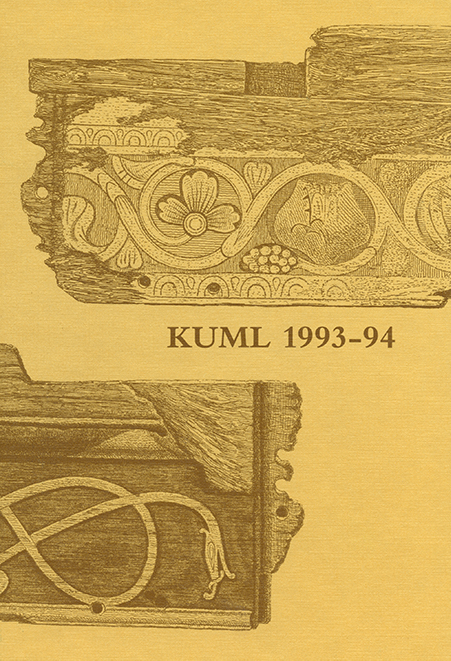The Lerchenborg Ornaments. Eastern connections in the Viking Age
DOI:
https://doi.org/10.7146/kuml.v39i39.111968Keywords:
Ornament, lerchenborg, viking age, women ornamentAbstract
The Lerchenborg Ornaments
Eastern connections in the Viking Age
New excavations in Russia and new publications of material from Birka in Sweden show how strong was the eastern inspiration of some Danish Viking Age material.
The Lerchenborg find reached the National Museum in 1889, and is regarded as coming from either a hoard or a grave (fig. 1). It is a complete set of women's ornaments consisting of the following.
Two tortoise brooches, a rectangular silver brooch, a round silver disc with niello decoration and loop, 3 silver beads and a bead of bronze wire, two doubled up pieces of silver wire each with 3 glass beads on it and another with 1 bead, a «braided" silver cable, 35 beads, 4 coins (two Kufic, one Frankish with loop, and a Scandinavian copy of a Frankish coin). The form and decoration of the tortoise brooches, which accords with type P 51, dates the find to the 10th century A.D. (fig. 2)
The Lerchenborg find differs from other graves with 10th century tortoise brooches through its many imports. The cable with a coin and other accessories on it may be noted. Seven graves at Birka have produced 14 pendants on braided cables. The silver disc is related in style to the Terslev ornaments. The distribution of these shows concentrations in the SE Scandinavian area with outliers in northern Germany and the Baltic area.
Another unusual feature of the Lerchenborg find is the number of beads, 41 of which are glass or millefiori, and one is carnelian. Carnelian beads are unusual in Denmark, but a parallel is known from Fyrkat. They are thought to have been manufactured at workshops in Kiev, and their diffusion followed the Russian rivers to northern and central Europe. There are also 4 silver beads. One is oval and decorated with S-shaped filigree coils. Beads of this kind are found mainly in central and eastern Sweden, including Gotland, and in the Baltic states and Russia. A similar ornament combining beads and tortoise brooches comes from grave VI at the Tuna boat-grave cemetery (fig. 3). Two of the Lerchenborg coins are Kufic, the oriental coins imported to Scandinavia especially in the tenth century.
From the above it can be seen that the Lerchenborg find had connections with Sweden and Russia. Near the headwaters of the Dniepr and at the town of Gnezdovo have been found cemeteries with typical Slavic and Scandinavian ornaments, showing a mixture of Russian and Scandinavian culture. The Dniepr flows down to the Black Sea, whence trade proceeded to Constantinople, which was a powerful centre in the 10th century. Constantinople became the focal point of Frankish and Scandinavian trade with the Orient. One of the most important wares was silk, which at first was brought from China along the Silk Road, but later was produced near Constantinople. A number of graves with imported silk have been found at Birka, demonstrating the riches and power of the town's inhabitants. There are no textiles in the Lerchenborg find, but about 30 km away at Slotsbjergby there were found gold thread and textile fragments. Slotsbjerg is close to Trelleborg, which was a centre of power on Zealand in the 10th century. Gold thread and silk are known from half a score of Danish finds from the 10th century, characteristically containing imported objects. In Jutland choice textile fragments were found at Mammen near Viborg, and at Jelling. From Funen there is the ship-grave from Ladby, whose equipment included some gold-thread ornaments in the form of a sort of buttons for an orientally inspired tunica. These discoveries of choice textile remains are thought to have belonged to the clothing of persons who possessed considerable political and economic power.
This was the environment of the Lerchenborg woman. Her outfit is parallelled on 5th century Byzantine mosaics at Ravenna. An example is the portrait of the Byzantine empress Theodora with her entourage (fig. 4), who is wearing a collar of chains and pendants. In the ensuing centuries Byzantine-inspired dress fashions evolved in courtly environments in both France and Russia, as is supported by Ibn Fadlan's account from 921 in which he described female neckwear. The archaeological material, the pictures, and the written sources all suggest that the Lerchenborg woman had a high social status and that she had contacts with the east. It may be left open whether it was for family, commercial, or political reasons that these eastern ornaments reached Lerchenborg.
Anne Hedeager Krag
Downloads
Published
How to Cite
Issue
Section
License
Fra og med årgang 2022 er artikler udgivet i Kuml med en licens fra Creative Commons (CC BY-NC-SA 4.0).
Alle tidligere årgange af tidsskriftet er ikke udgivet med en licens fra Creative Commons.


